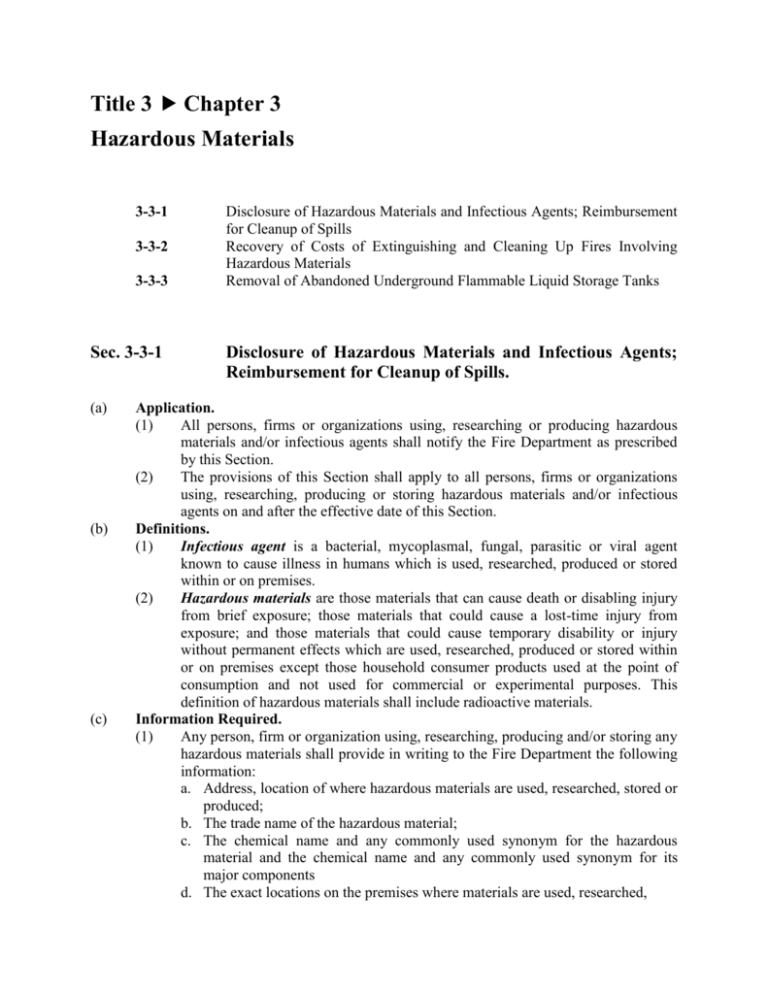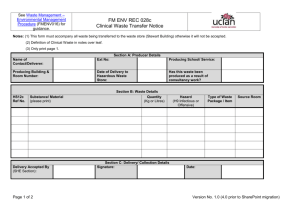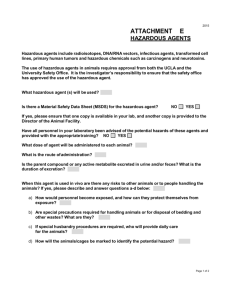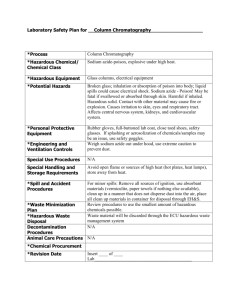Title 3 „ Chapter 3
advertisement

Title 3 Chapter 3 Hazardous Materials 3-3-1 3-3-2 3-3-3 Sec. 3-3-1 (a) (b) (c) Disclosure of Hazardous Materials and Infectious Agents; Reimbursement for Cleanup of Spills Recovery of Costs of Extinguishing and Cleaning Up Fires Involving Hazardous Materials Removal of Abandoned Underground Flammable Liquid Storage Tanks Disclosure of Hazardous Materials and Infectious Agents; Reimbursement for Cleanup of Spills. Application. (1) All persons, firms or organizations using, researching or producing hazardous materials and/or infectious agents shall notify the Fire Department as prescribed by this Section. (2) The provisions of this Section shall apply to all persons, firms or organizations using, researching, producing or storing hazardous materials and/or infectious agents on and after the effective date of this Section. Definitions. (1) Infectious agent is a bacterial, mycoplasmal, fungal, parasitic or viral agent known to cause illness in humans which is used, researched, produced or stored within or on premises. (2) Hazardous materials are those materials that can cause death or disabling injury from brief exposure; those materials that could cause a lost-time injury from exposure; and those materials that could cause temporary disability or injury without permanent effects which are used, researched, produced or stored within or on premises except those household consumer products used at the point of consumption and not used for commercial or experimental purposes. This definition of hazardous materials shall include radioactive materials. Information Required. (1) Any person, firm or organization using, researching, producing and/or storing any hazardous materials shall provide in writing to the Fire Department the following information: a. Address, location of where hazardous materials are used, researched, stored or produced; b. The trade name of the hazardous material; c. The chemical name and any commonly used synonym for the hazardous material and the chemical name and any commonly used synonym for its major components d. The exact locations on the premises where materials are used, researched, (d) stored and/or produced; e. Amounts of hazardous materials on premises per exact location; f. The boiling point, vapor pressure, vapor density, solubility in water, specific gravity, percentage volatile by volume, evaporation rate for liquids and appearance and odor of the hazardous material; g. The flashpoint and flammable limits of the hazardous substance; h. Any permissible exposure level, threshold limit value or other established limit value for exposure to a hazardous material; i. The stability of the hazardous substance; j. Recommended fire extinguishing media, special firefighting procedures and fire and explosion hazard information for the hazardous material; k. Any effect of over-exposure to the hazardous material, emergency and first aid procedures and telephone numbers to call in an emergency; l. Any condition or material which is incompatible with the hazardous material and must be avoided. m. Any personal protective equipment to be worn or used and special precautions to be taken when handling or coming into contact with the hazardous materials; n. Procedures for handling or coming into contact with the hazardous materials. (2) Any person, firm or organization using, researching, producing and/or storing infectious agent and/or carrier of an infectious agent shall provide in writing to the Fire Department the following: a. The name and any commonly used synonym of the infectious agent; b. Address/location where infectious agents are used, researched, stored and/or produced; c. The exact locations where infectious agents are used, researched, stored and/or produced; d. Amount of infectious agent on premises per exact locations; e. Any methods of route of transmission of the infectious agents; f. Any symptoms of effect of infection, emergency and first aid procedure and a telephone number to be called in an emergency; g. Any personal protective equipment to be worn or used and special precautions to be taken when handling or coming in contact with the infectious agent; h. Procedure for handling, clean-up and disposal of infectious agents leaked or spilled. Reimbursement for Cleanup of Spills. Any person who possesses or controls a hazardous material or infectious agent which was discharged or caused the discharge of a hazardous material or infectious agent shall reimburse the Town for actual and necessary expenses incurred by the Town or its agent to contain, remove or dispose of the hazardous substance or infectious agent or take any other appropriate action which is deemed appropriate under the circumstance. Sec. 3-3-2 (a) Recovery of Costs. Every person, firm or corporation using, storing, handling or transporting flammable or (b) combustible liquids, chemicals, gasses or other hazardous materials shall comply with the requirements of the Wisconsin Administrative Code as the same is now in force and may hereafter from time to time be amended. Every person, firm or corporation using, storing, handling or transporting (whether by rail or on the highways) flammable or combustible liquids, chemicals, gasses or other hazardous materials shall be liable to the Town for the actual cost of labor and materials associated with the use of any specialized extinguishing agent, chemical, neutralizer or similar material or equipment employed to extinguish, confine or clean up any such hazardous material which is involved in any accidental spill or in threat of any fire or accidental spill. Sec. 3-3-3 Removal of Abandoned Underground Flammable Liquid Storage Tanks. Underground flammable liquid storage tanks which are abandoned, as defined in ILHR 10, Wis. Adm. Code, shall not be abandoned in place. Such tanks shall be removed within ninety (90) days from the date they become abandoned and the excavation filled with clean, well-compacted fill to the surface of the adjacent grade.






